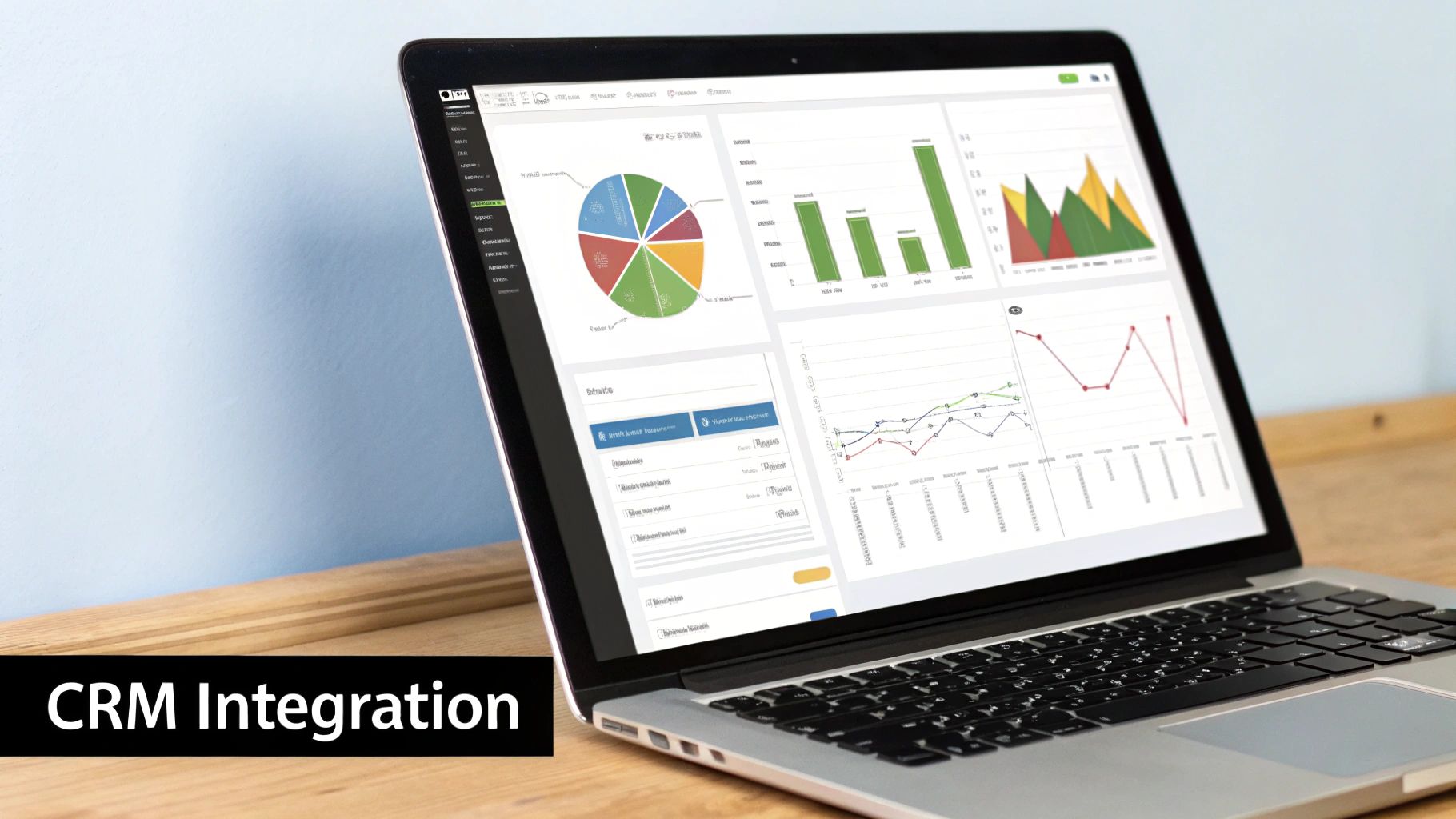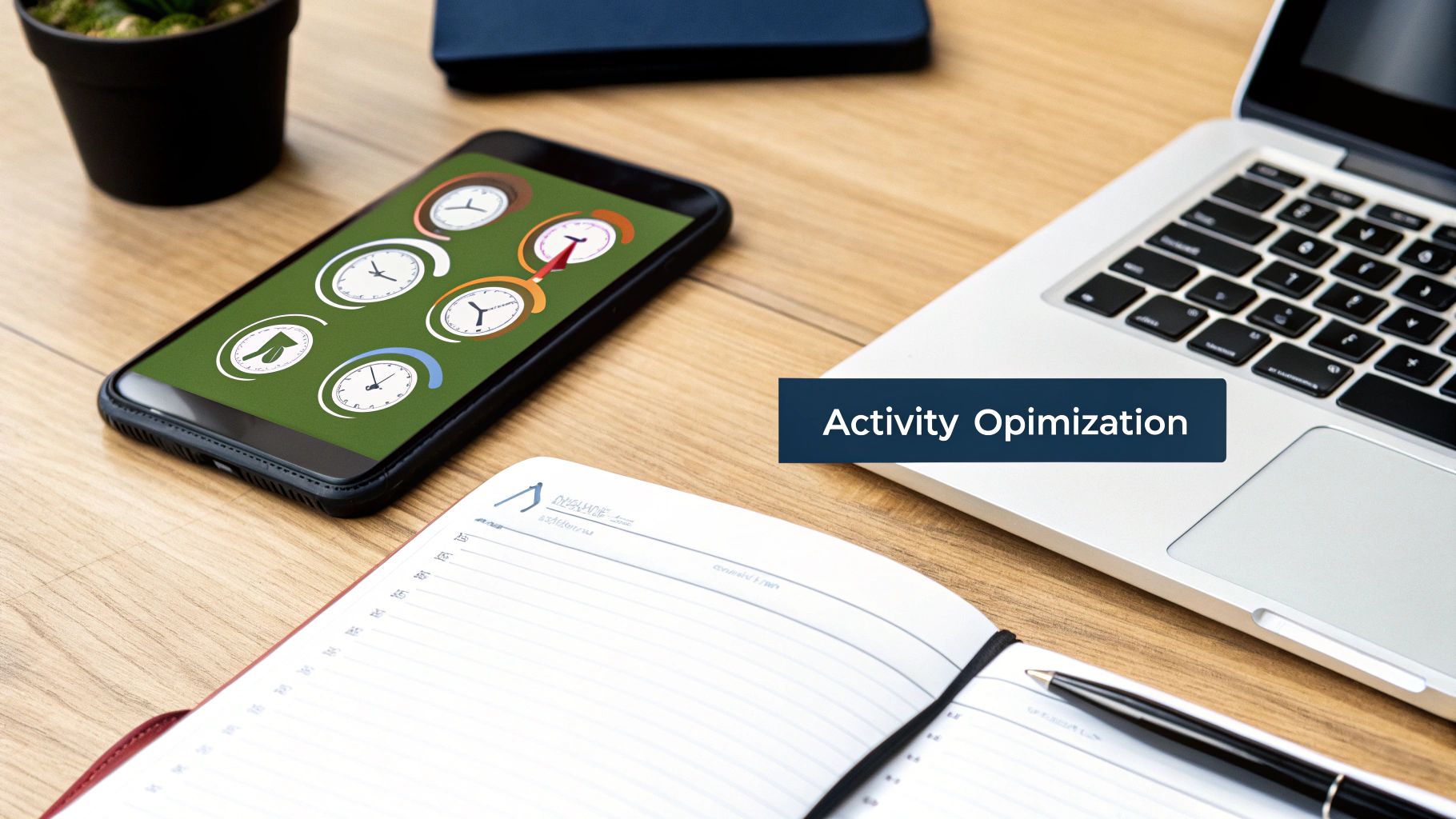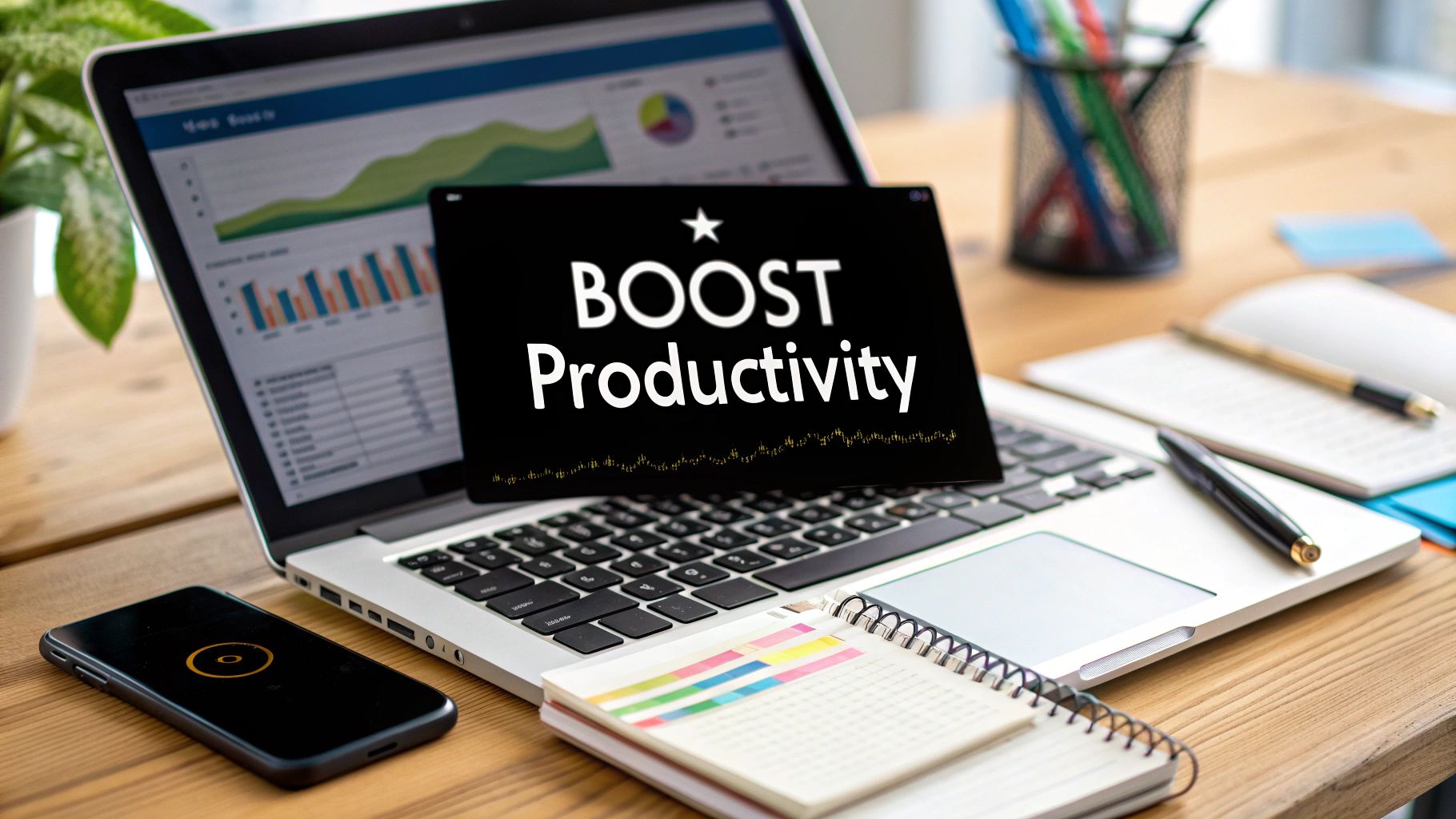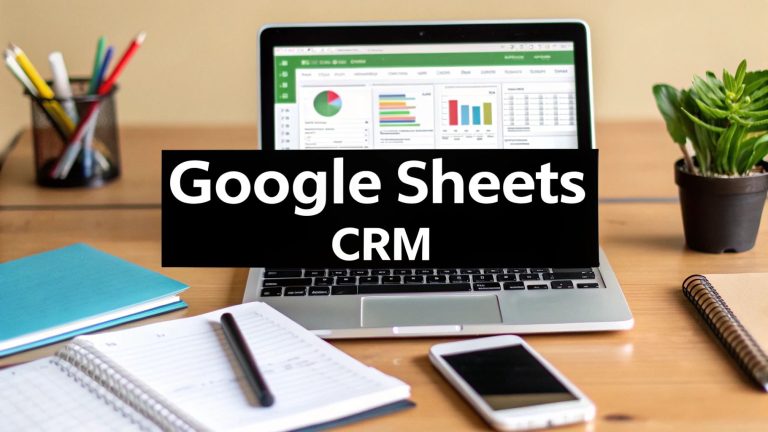Boost Revenue: 9 Ways to Improve Sales Productivity Today
In the fast-paced world of sales, activity is often mistaken for achievement. Teams can be incredibly busy- making calls, sending emails, and updating spreadsheets- yet still fall short of revenue targets. The critical difference lies in productivity: focusing efforts on high-impact activities that consistently move deals forward. The challenge isn't about working harder; it's about working smarter.
Outdated manual processes, such as downloading leads from social media platforms, create significant delays and administrative burdens that kill momentum. When a high-intent lead from a Facebook ad has to wait hours or even days for a follow-up, their interest wanes, and competitors gain a crucial advantage. This article breaks down nine powerful, field-tested strategies designed to help you streamline operations, eliminate bottlenecks, and ultimately improve sales productivity.
We'll explore how to refine your sales process, implement powerful technology, and empower your team to focus on what they do best: selling. From optimizing lead capture with tools like LeadSavvy Pro to implementing structured coaching, these actionable insights will transform your team from simply busy to truly productive. You will learn specific, practical methods to drive measurable growth and boost your closing rates.
1. Sales Process Optimization
Sales process optimization is the systematic analysis and refinement of every stage in your sales funnel. The goal is to eliminate inefficiencies, standardize best practices, and create a predictable path to closing deals. This involves mapping out the entire customer journey, from initial contact to the final sale, identifying bottlenecks, and implementing repeatable procedures that guide your team effectively. A well-optimized process is a cornerstone to improve sales productivity, ensuring every representative follows a proven method for success.

By defining clear stages and actions, you remove guesswork and empower reps to focus on building relationships and closing deals rather than figuring out what to do next. For example, Salesforce standardized its sales process across all divisions, resulting in a reported 25% faster deal closure.
How to Implement Sales Process Optimization
To effectively optimize your process, start with a collaborative audit and leverage data to guide your decisions.
- Map Your Current Process: Gather your top-performing reps and map out every step they currently take. Document the touchpoints, tools used, and criteria for moving a lead to the next stage.
- Analyze CRM Data: Dive into your CRM analytics to pinpoint where deals most often stall or are lost. This data-driven approach highlights the exact friction points that need attention.
- Standardize and Document: Based on your findings, create a standardized sales playbook. This document should outline each stage, key activities, required qualifications, and best-practice scripts or email templates.
- Align with Marketing: Ensure your sales stages are perfectly aligned with the marketing funnel. A lead marked as "Marketing Qualified" should meet specific criteria that make them "Sales Ready" for a seamless handoff.
2. CRM and Sales Technology Integration
CRM and sales technology integration is the strategic implementation of Customer Relationship Management systems alongside sales enablement tools. This synergy automates routine tasks, centralizes customer data, and provides actionable insights that empower your team. By unifying your technology stack, you create a single source of truth that transforms how sales reps manage leads, track interactions, and make data-driven decisions. This integrated approach is fundamental to improve sales productivity by eliminating manual data entry and streamlining workflows.

A well-integrated system ensures that valuable information flows seamlessly between platforms, from lead capture tools like LeadSavvy Pro directly into your CRM. This gives reps immediate access to critical context, reducing follow-up time and increasing conversion rates. For instance, Coca-Cola reportedly increased sales productivity by 40% after a comprehensive Salesforce implementation, demonstrating the massive impact of a unified tech stack.
How to Implement CRM and Sales Technology Integration
Effective integration requires careful planning, a focus on user adoption, and continuous optimization to maximize its value.
- Audit and Select Compatible Tools: Evaluate your current technology and identify gaps. Choose a CRM and other sales tools that offer robust, native integrations to avoid complex custom development. If you're starting fresh, you can learn more about some of the best free CRM tools available.
- Prioritize User Training and Adoption: Technology is only effective if your team uses it correctly. Invest heavily in comprehensive training programs that show reps how the new system makes their jobs easier and more efficient.
- Automate Judiciously: Use automation to handle repetitive tasks like logging calls, sending follow-up emails, or updating deal stages. However, preserve the human touch for critical relationship-building activities.
- Maintain Data Hygiene: Implement strict processes for data entry and conduct regular audits to clean and validate your CRM data. Accurate data is the foundation for reliable reporting and effective decision-making.
3. Sales Coaching and Training Programs
Sales coaching and training programs are a systematic approach to developing individual and team sales capabilities. This strategy moves beyond one-off training events, focusing instead on continuous learning, structured skill development, and personalized performance feedback. By implementing ongoing mentorship and role-playing exercises, businesses can address specific weaknesses, reinforce best practices, and elevate the entire team's performance. This commitment to development is essential to improve sales productivity, transforming good reps into great ones.

A well-executed training program delivers tangible results. For instance, Xerox implemented structured sales training that successfully reduced the ramp-up time for new hires by 40%, demonstrating how targeted education directly accelerates a rep's ability to contribute to revenue. These programs build a culture of excellence and continuous improvement.
How to Implement Sales Coaching and Training Programs
Effective coaching programs are personalized, data-driven, and integrated into the daily sales workflow.
- Focus on Measurable Behaviors: Instead of generic advice like "be more confident," focus coaching on specific actions. Analyze call recordings to provide targeted feedback on phrasing, question-asking techniques, or objection handling.
- Implement Peer Mentorship: Pair new or struggling reps with top performers. Peer coaching creates a supportive learning environment and leverages the practical expertise already within your team.
- Customize Training Content: Recognize that not all reps have the same needs. Tailor training modules to address individual weaknesses, whether it's prospecting, discovery calls, or closing techniques.
- Assess and Adapt: Regularly measure the effectiveness of your training through performance metrics like conversion rates, deal size, and sales cycle length. Use this data to refine your coaching strategy and ensure it delivers a strong ROI.
4. Lead Qualification and Scoring Systems
Lead qualification and scoring systems are a methodical approach to evaluating and ranking prospects based on their likelihood to purchase. This strategy uses both demographic and behavioral data to assign a score, helping sales teams prioritize their efforts on the most promising opportunities. By systematically identifying high-value leads, you can significantly improve sales productivity and ensure that your team’s time is spent engaging prospects who are genuinely ready to buy, rather than chasing cold trails.

A well-implemented scoring model filters out unqualified leads and highlights those demonstrating strong buying signals. For example, Adobe successfully leveraged sophisticated lead qualification to boost its sales productivity by 35%, directing its team’s energy toward the most convertible prospects. Similarly, Lenovo used an improved scoring system to reduce its sales cycle time by a remarkable 25%.
How to Implement Lead Qualification and Scoring
To build an effective system, start with a clear framework and refine it based on performance data. Use a detailed lead qualification checklist to guide your process from the beginning.
- Define Your Ideal Customer Profile (ICP): Document the firmographic and demographic attributes of your best customers. Assign point values to criteria like company size, industry, job title, and geographic location.
- Track Engagement Signals: Award points for behavioral data that indicates interest. This includes actions like visiting your pricing page, downloading a whitepaper, or requesting a demo.
- Implement Negative Scoring: Deduct points for actions that suggest a poor fit. This could include visits to your careers page, activity from a student email address, or engagement from a non-target industry.
- Align Sales and Marketing: Collaborate to establish a clear definition of a "Sales Qualified Lead" (SQL). Ensure both teams agree on the score threshold that triggers a handoff, creating a seamless and efficient workflow.
5. Account-Based Selling (ABS)
Account-Based Selling (ABS) is a hyper-focused strategic approach where sales and marketing teams treat high-value target accounts as individual markets. Instead of casting a wide net, this methodology concentrates resources on a select group of accounts, orchestrating personalized campaigns to engage key stakeholders. By aligning efforts and tailoring messaging to the specific challenges and goals of each target, ABS fosters deeper relationships and drives larger, more strategic deals. This focus on quality over quantity is a powerful way to improve sales productivity by channeling energy where it will have the greatest impact.
This targeted strategy yields significant results by creating a highly relevant buying experience. For instance, the cloud data platform Snowflake credits its ABS approach for contributing to a staggering 174% revenue growth, while Terminus used account-based strategies to increase its average deal size by 45%.
How to Implement Account-Based Selling
Effective ABS implementation requires deep research, cross-departmental alignment, and a commitment to personalization.
- Identify High-Value Accounts: Collaborate with leadership to define your Ideal Customer Profile (ICP). Use firmographic data like industry, company size, and revenue, as well as technographic and intent data, to select a small, manageable list of target accounts.
- Map Stakeholders and Research: Invest time in comprehensive account research. Identify key decision-makers, influencers, and blockers within each organization. Map out their roles, pain points, and reporting structures to understand the internal landscape.
- Develop Personalized Messaging: Craft account-specific value propositions and outreach campaigns. Your messaging should address the unique business challenges and strategic objectives of each target account, demonstrating a clear understanding of their world.
- Coordinate Cross-Functional Plays: True ABS is a team sport. Align your sales, marketing, and customer success teams to execute coordinated plays. This ensures a consistent and seamless experience for the account across all touchpoints, from initial ad exposure to post-sale support.
6. Sales Activity Optimization
Sales activity optimization is the systematic analysis and improvement of daily sales tasks to maximize productive selling time and minimize non-revenue-generating activities. This strategy, championed by experts like Anthony Iannarino, focuses on identifying high-impact behaviors that directly lead to sales and ruthlessly eliminating or automating low-value work. By doing so, you can significantly improve sales productivity and ensure your team's efforts are concentrated where they matter most.
The need for this is clear: Salesforce research found that reps spend only 34% of their time actually selling. By optimizing their activities, LinkedIn was able to increase its team's selling time by 30%. This approach shifts the focus from being busy to being productive, ensuring every action contributes directly to closing deals.
How to Implement Sales Activity Optimization
To effectively optimize your team's daily activities, you need to measure, analyze, and protect your most valuable asset: time.
- Track Time and Activities: For a two-to-four-week period, have your sales reps meticulously track how they spend their time. Use time-tracking tools or simple logs to categorize activities like prospecting, data entry, internal meetings, and active selling.
- Identify High-Impact Actions: Analyze the data to find correlations between specific activities and closed deals. Which behaviors, like personalized follow-ups or discovery calls, consistently lead to revenue? These are your core, high-value activities.
- Automate or Eliminate Low-Value Tasks: Identify tasks that consume time but do not contribute to sales, such as manual data entry or report generation. Use tools like LeadSavvy Pro to automate lead capture and notifications, freeing up reps to focus on selling.
- Implement Calendar Blocking: Instruct your team to use calendar blocking to protect their prime selling hours. By scheduling dedicated, uninterrupted blocks for prospecting and client calls, you prevent distractions from derailing productive work.
7. Pipeline Management and Forecasting
Pipeline management and forecasting involve a disciplined approach to managing sales opportunities through systematic review, accurate prediction, and proactive deal advancement. The goal is to create a reliable and predictable revenue stream by ensuring the sales pipeline is healthy, balanced, and moving forward. This strategy is crucial to improve sales productivity, as it helps teams focus their efforts on deals that are most likely to close and identify potential roadblocks before they jeopardize targets.
A well-managed pipeline provides clarity on future revenue and highlights where reps should invest their time. For instance, Workday achieved over 90% forecast accuracy by implementing systematic pipeline management, allowing for better resource allocation and strategic planning. A structured process removes ambiguity and ensures every opportunity is handled with precision.
How to Implement Pipeline Management and Forecasting
Effective implementation hinges on establishing clear rules, conducting regular reviews, and using data to guide your strategy.
- Establish Clear Stage Criteria: Define what must happen for a deal to move from one stage to the next. This could include a completed demo, a submitted proposal, or a verbal commitment. This ensures that every deal in a given stage has met the same qualifications.
- Conduct Regular Pipeline Reviews: Hold weekly or bi-weekly pipeline review meetings with a standardized agenda. Focus on deal velocity, identify stalled opportunities, and strategize on next steps to advance key accounts.
- Use Historical Data for Forecasting: Analyze past conversion rates between stages to create more accurate sales forecasts. If you know that historically 50% of deals in the proposal stage close, you can apply this probability to your current pipeline for a more realistic projection.
- Focus on Deal Quality over Quantity: Encourage reps to pursue high-quality, well-qualified leads rather than simply filling the pipeline with low-probability opportunities. A smaller, healthier pipeline often yields better results than a large, bloated one. Learn more about sales pipeline management tips on leadsavvy.pro.
8. Social Selling and Digital Outreach
Social selling and digital outreach involve leveraging social media platforms to build relationships, establish thought leadership, and engage prospects in meaningful conversations. Instead of cold calling, this modern approach focuses on providing value and building trust through digital interactions, positioning reps as advisors rather than just sellers. By meeting buyers where they are already active, you can warm up leads and significantly improve sales productivity.
This strategy humanizes the sales process and allows reps to connect with prospects on a more personal level. For instance, IBM's renowned social selling program was instrumental in generating over $1 billion in revenue, proving that strategic digital engagement directly translates to tangible business growth. The key is to engage authentically and consistently.
How to Implement Social Selling and Digital Outreach
To succeed with social selling, focus on building your digital presence and engaging with purpose before you ever make a pitch.
- Optimize Your LinkedIn Profile: Treat your LinkedIn profile as a landing page. Use a professional headshot, write a compelling, customer-centric summary, and highlight key achievements.
- Share Valuable Content: Regularly post and share content that is relevant to your target audience's pain points. This establishes your expertise and keeps you top-of-mind without being overtly promotional.
- Engage Before You Connect: Interact with a prospect's content by liking, commenting, or sharing their posts before sending a connection request. This builds familiarity and makes your outreach feel less cold.
- Personalize Your Outreach: Use insights gathered from a prospect's social media activity to tailor your connection requests and messages. Mention a recent post, a shared connection, or a mutual interest to stand out.
9. Customer Success and Expansion Strategy
A customer success and expansion strategy shifts focus from purely acquiring new logos to nurturing and growing your existing customer base. This approach recognizes that retaining and expanding current accounts is often far more cost-effective and profitable than hunting for new business. It involves proactively ensuring customers achieve their desired outcomes with your product, which in turn builds loyalty and opens doors for upselling and cross-selling. A robust customer success program is a powerful way to improve sales productivity by creating a predictable revenue stream from happy clients.
By investing in the post-sale journey, you transform one-time buyers into long-term partners. For instance, SaaS giant Salesforce famously generates a significant portion of its revenue from existing customers, while Zoom achieved a 130% net dollar expansion rate by focusing on customer-centric growth. This proves that your biggest growth opportunities may already be on your payroll.
How to Implement a Customer Success and Expansion Strategy
To build an effective program, you need to combine proactive monitoring with systematic processes for identifying and acting on growth opportunities.
- Implement Customer Health Scoring: Use a system to track customer engagement, product usage, and support tickets. This data helps you create a "health score" to proactively identify at-risk accounts or those ripe for expansion before they churn.
- Create a Systematic Onboarding Process: A structured onboarding experience ensures new customers achieve their first "win" quickly. This builds early momentum and sets the foundation for a successful long-term relationship.
- Conduct Regular Business Reviews (QBRs): Schedule quarterly business reviews with key accounts to discuss their progress, realign on goals, and strategically identify opportunities for upselling or cross-selling new solutions that solve their evolving needs.
- Align Sales and Success Incentives: Ensure both your sales and customer success teams are compensated for retention and expansion. This alignment creates a unified focus on the entire customer lifecycle, not just the initial close.
9 Strategies to Improve Sales Productivity Comparison
| Strategy | Implementation Complexity 🔄 | Resource Requirements ⚡ | Expected Outcomes 📊 | Ideal Use Cases 💡 | Key Advantages ⭐ |
|---|---|---|---|---|---|
| Sales Process Optimization | Medium to High: Requires time and ongoing updates | Moderate: Involves team training and CRM alignment | Improved conversion rates, shorter sales cycles | Teams needing standardized methodologies and forecasting | Consistent execution, easier onboarding, clear metrics |
| CRM and Sales Technology Integration | High: Setup, integration, and training intensive | High: Licensing, training, data management | Increased productivity, faster response times | Organizations automating and centralizing sales data | Reduces admin tasks, powerful analytics, improves collaboration |
| Sales Coaching and Training Programs | Medium to High: Requires ongoing manager involvement | Moderate to High: Training program costs | Higher individual performance, reduced turnover | Firms focusing on skill development and sales growth | Builds confidence, consistent messaging, rapid onboarding |
| Lead Qualification and Scoring Systems | Medium: Data analysis and model refinement needed | Moderate: Data tools and marketing integration | Higher conversion rates, better resource focus | Companies aiming to prioritize high-potential leads | Data-driven prioritization, efficient sales focus |
| Account-Based Selling (ABS) | High: Intensive research and personalized effort | High: Skilled resources and multi-team collaboration | Higher deal sizes, stronger relationships | Targeting high-value accounts with customized campaigns | Increased deal values, customer loyalty, better alignment |
| Sales Activity Optimization | Medium: Detailed time tracking and process change | Moderate: Automation tools and training | More selling time, less burnout | Teams needing to maximize productive sales activities | Increases selling time, reduces burnout, clear performance |
| Pipeline Management and Forecasting | Medium: Requires discipline and regular reviews | Moderate: CRM and analytics support | Improved forecast accuracy, proactive deal management | Organizations needing consistent and predictable revenue | Better resource allocation, early risk detection |
| Social Selling and Digital Outreach | Medium: Time-intensive personal branding and engagement | Low to Moderate: Social media tools | Increased reach and warm leads | Sales relying on digital channels and thought leadership | Builds trust, lowers prospecting cost, expands reach |
| Customer Success and Expansion Strategy | Medium: Requires customer success resources and coordination | Moderate: Customer success tools and training | Higher retention, increased expansion revenue | Focus on growing existing accounts and reducing churn | Predictable revenue, stronger loyalty, higher margins |
Transform Your Sales Workflow from Manual to Automated
Boosting sales productivity is not a one-time fix but a continuous journey of strategic refinement. Throughout this guide, we've explored a comprehensive framework for elevating your team's performance, moving beyond generic advice to provide actionable strategies. From optimizing your core sales process and implementing robust CRM integrations to developing targeted coaching programs and mastering social selling, each element plays a crucial role in building a high-functioning sales engine. The common thread connecting these powerful tactics is the deliberate shift from manual, time-consuming tasks to automated, efficient workflows.
Key Takeaways for Sustainable Growth
To truly improve sales productivity, focus on the cumulative impact of small, consistent changes. The most successful sales organizations don't just work harder; they work smarter by systematically eliminating friction points. This involves:
- Process Over Preference: Standardizing your sales process, from lead qualification to pipeline management, ensures consistency and provides a clear baseline for measuring success.
- Technology as an Enabler: Leveraging the right technology, like a well-integrated CRM and specialized tools, automates repetitive administrative tasks, freeing up your team to focus on high-value activities like building relationships and closing deals.
- Empowerment Through Skills: Investing in continuous training, especially in areas like account-based selling and digital outreach, equips your reps with the modern skills needed to connect with today's informed buyers.
- Data-Driven Decisions: Implementing lead scoring and accurate forecasting transforms your approach from guesswork to a predictable, data-backed strategy.
Your First Step Toward Automation and Efficiency
Mastering these concepts is essential because it fundamentally changes your team's capacity. When you remove administrative burdens, you create more time for selling. When you provide clear processes and effective coaching, you enhance the quality of every interaction. The result is a more motivated, effective, and productive sales team capable of driving predictable revenue growth and building stronger customer relationships.
The most significant and often simplest bottleneck to address first is lead management, especially for teams running digital ad campaigns. The time spent manually downloading lead lists from platforms like Facebook is a direct drain on productivity and a critical delay in follow-up. Each minute wasted is an opportunity for a competitor to engage your hard-won lead. This is precisely where automation delivers its most immediate return on investment. By bridging this gap, you ensure that every prospect receives the prompt, professional attention they expect, dramatically increasing your conversion rates and setting a new standard for efficiency.
Ready to take the first, most impactful step to improve sales productivity? Stop letting valuable leads slip through the cracks due to manual data entry. See how LeadSavvy Pro instantly captures and sends your Facebook leads directly to your sales team, eliminating delays and maximizing your ROI. Start your free plan today and transform your lead management from a chore into a competitive advantage.







